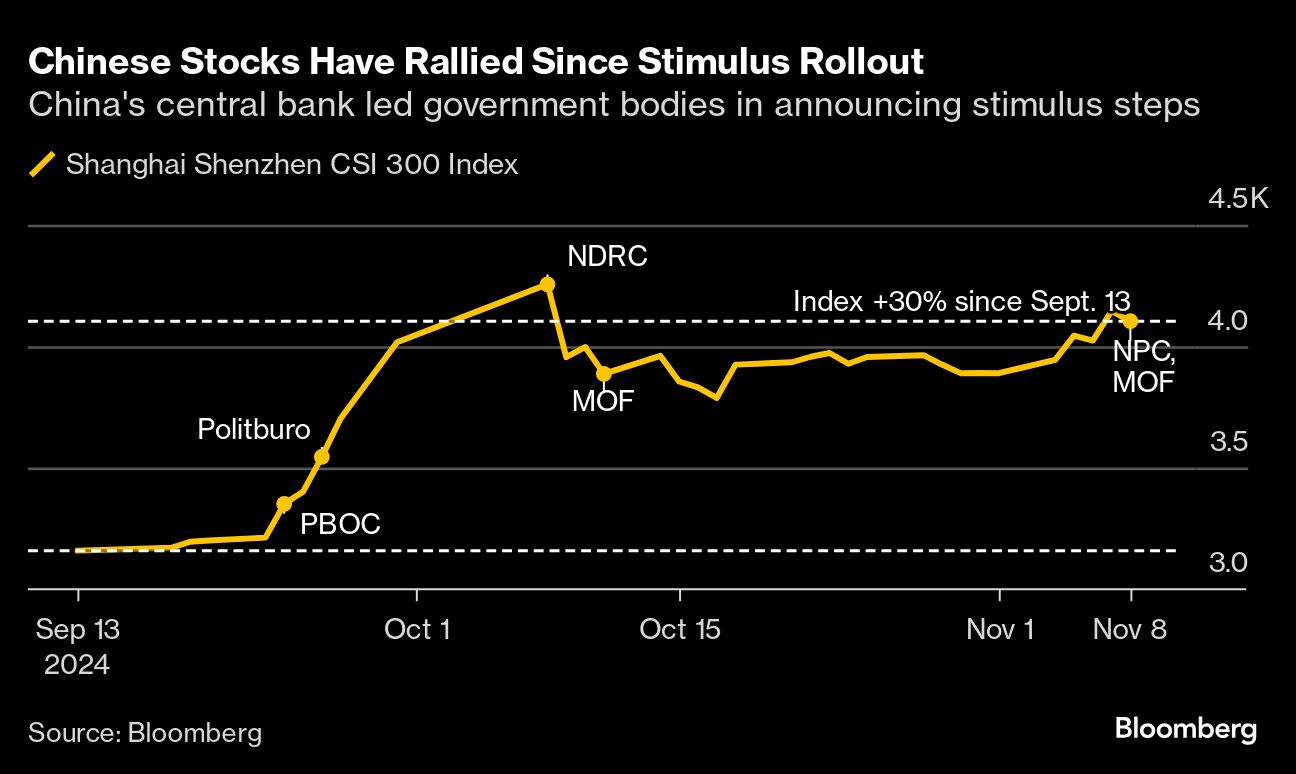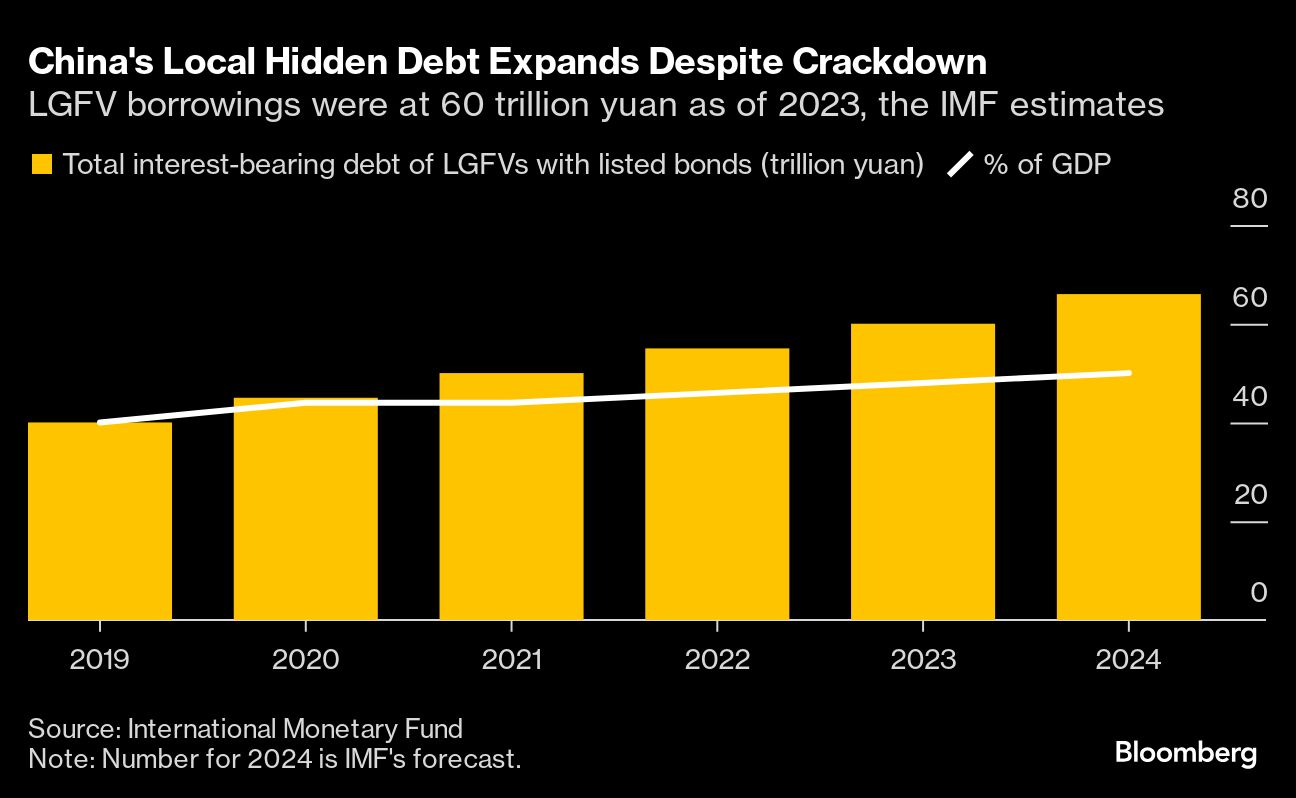
(Nov 8): China gave indebted local governments a 10 trillion yuan (US$1.4 trillion or RM6.12 trillion) lifeline but stopped short of unleashing new stimulus, preserving room to respond to a potential trade war when Donald Trump takes office next year.
Officials unveiled the details of a plan to swap hidden debt authorized by the Standing Committee of the National People’s Congress at a press briefing in Beijing on Friday. Funds for that programme — telegraphed last month but without a price tag — will be provided through 2028, they said.
While policymakers didn’t announce measures to directly stimulate domestic demand, Finance Minister Lan Fo’an promised “more forceful” fiscal policy next year, signalling bolder steps could come after Trump’s inauguration in January. The US president-elect has threatened 60% tariffs on Chinese goods that could decimate trade between the world’s largest economies, and blight exports that have been a rare bright spot for the Asian nation this year.
“Policymakers probably saw no need for a robust response to Trump’s victory before he takes office, given the relatively restrained post-election market response,” said Duncan Wrigley, chief China economist with Pantheon Macroeconomics. “Next year is a different matter, but officials will take that as it comes.”
China’s boldest stimulus blitz since the pandemic has sent onshore shares soaring by about 30% since September, taking the pressure off officials to act immediately. Those rate cuts, along with stock and housing market support pledges, have put President Xi Jinping on track to hit this year’s growth goal of around 5%, without taking on piles of extra debt to reflate the economy.
Investors had waited for weeks for the fiscal side of that campaign, with media reports stoking expectations for more spending to stabilise the property market and boost consumption. Disappointment was palpable at the start of the presser, with the offshore yuan weakening as much as 0.6% before paring the decline to 0.3% as the full scale of the package was known.
"Local debt resolution is a critical aspect of policy support. But it’s only part of a broader push that’s required to revive the economy. With this package, local officials may be able to start catching up on spending allocated in this year’s budget. To boost growth in a more sustainable way, other important aspects are likely to come, particularly more specific fiscal measures to support demand," said Chang Shu, Eric Zhu, economists at Bloomberg Economics.
China’s top leader has labelled local government debt one of the three “major economic and financial risks” facing his country, as he tries to steady the nation’s slowing economy. Most of these borrowings are tied to entities known as local government financing vehicles, which borrow on behalf of provinces and cities to finance investment in infrastructure.
Local authorities that relied on land sales for revenue have struggled to service those liabilities in recent years as the property crisis wiped out demand for new building. Officials at the briefing said the outstanding value of so-called hidden debt was 14.3 trillion yuan as of the end of 2023, although the International Monetary Fund has put that figure at about 60 trillion yuan.
While markets shrugged off the measures, Lan called the package “a major policy decision taking into consideration international and domestic development environments.” Policymakers also took the rare step of raising local governments’ debt ceiling mid-year for the first time since 2015.
That increase in the debt limit will allow local governments to issue six trillion yuan in additional special bonds over three years to swap hidden debt, Lan said at the briefing. Regional authorities will be able to tap another total of four trillion yuan in special local bond quota to be approved in tranches over five years — including 2024 — for the same purpose, he added.
“To really have a positive for markets, you want to see something which is two trillion or above specifically talking about consumption-related stimulus,” Bernie Ahkong, CIO at UBS O’Connor Global Multi Strategy Alpha told Bloomberg TV.
Investors will now be looking to December for the next major window for bigger fiscal measures, when the 24-man Politburo will discuss the economy at a monthly meeting and policymakers will huddle at the annual Central Economic Work Conference. By then, officials could have greater clarity on Trump’s stance on tariffs, and more time to devise a fiscal strategy to fireproof the economy.
Officials could still unveil a “meaningful” fiscal package in the near term, according to Xiaojia Zhi, head of research at Credit Agricole CIB. Additional spending of 12 to 13 trillion yuan is possible in the next three years, to offset the impact from aggressive US tariff hikes, she added.
Explaining the impact of the package, Lan estimated the swap could save around 600 billion yuan in interest payments over five years, which would allow resources to boost investment and consumption. Another 2 trillion yuan in hidden debt related to the redevelopment of rundown homes will not come due until 2029, he said. That takes some pressure off local governments in the near future.
The push to cut hidden debt accumulated by local governments has been hailed by Morgan Stanley economists as a “critical” step in breaking a deflationary spiral and “equally important” to direct demand stimulus. Other analysts have argued that fiscal stimulus to bolster consumption would have a more direct and immediate impact on economic growth.
“From the fiscal management perspective, this is the right thing to do. But for the people concerned about the growth momentum of the economy, this will not address that in a significant way,” said Raymond Yeung, chief economist for Greater China at Australia & New Zealand Banking Group Ltd.
“I’m not saying this isn’t positive for growth,” he added, “but the impact would be pretty indirect and spread across many years.”
More points from the briefing:
- China’s government still has “large room” for borrowing; its debt, including the recognised hidden debt, is 67.5% of gross domestic product, lower than the average ratio of 123.4% in G7 countries
- Work on the bank recapitalisation programme, which is to be financed by special sovereign bond sales, is being advanced
- The Finance Ministry is working on detailed policies to expand the use of special local bonds for funding purchases of idle land and unsold homes; it will push for the policy’s roll-out at an early date
- Next year, China will expand the issuance of special local bonds and broaden their use and continue selling ultra-long special sovereign bonds
- It will also strengthen support for equipment upgrading and expand the types and scale of consumer goods to be included in the trade-in programme, and increase central government transfer payments to local areas
Uploaded by Felyx Teoh


